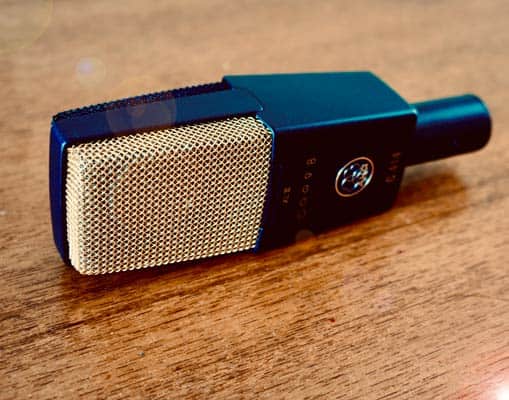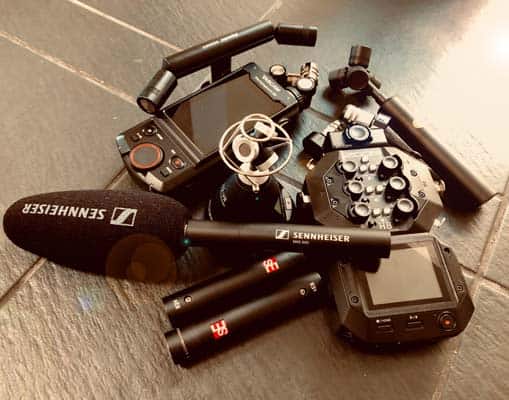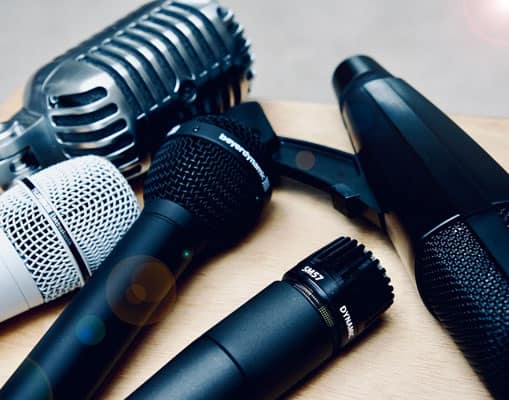What is Microphone Sensitivity? How is it Useful?
As discussed in Types of Microphones & How They Work, microphones measure alterations in air pressure and translate them into electrical signals. Some microphones translate these alterations into an electrical signals more efficiently than others.
In other words, some mics need more juice from your preamp than others. The specification that measures this efficiency is known as sensitivity.
A microphone’s sensitivity specifies the voltage level it produces when exposed to a specific amount of sound (or air pressure).
Sensitivity specifications help recordists choose more suitable mics for specific applications. Don’t be fooled into thinking that a mic with high sensitivity is inherently better than one with low sensitivity. You should use mics with high sensitivity for recording quiet sounds, use low sensitivity mics for recording loud sounds, and aim to find a sweet spot of balance between too much preamp gain and too little.
Sensitivity is a useful spec indeed! The problem is that sensitivity is not always measured in the same way. We hope to clear that up here.
In this article, we’ll discuss the confusion around Sensitivity specifications and how to compare them. And then we’ll discuss how you match your preamp’s gain with your mic.
See here for all things audio gear and here for knowledge and reviews of microphones.
Sensitivity and Microphone Choice
A microphone with higher sensitivity produces a stronger electrical signal for a given acoustic input. For instance, a microphone rated at 10 mV/Pa will output 10 millivolts when exposed to a sound pressure level of 1 pascal.
This higher output signal requires less amplification from the preamplifier, thus reducing the need for high-gain settings and minimizing the introduction of noise.
Conversely, a microphone with lower sensitivity might only produce 1 mV/Pa, generating a weaker signal under the same conditions. If you’re close miking a snare or a trumpet, a mic with lower sensitivity is a better fit as it will reduce the risk of distortion.
This weaker signal, however, demands more gain to be useful, which can amplify not just the desired audio but also the noise inherent in the microphone and preamplifier circuitry.
In the table below are the sensitivity specs of some popular microphones. We’ve converted the measurements so that they are expressed in mV/Pa and dBV (using our microphone sensitivity calculator). This way, you can compare the specs apples to apples.
Sensitivity Specs of Some Popular Microphones Compared (Table 1)
| Microphone Type | mV/Pa | dBV | |
| Shure SM7B | Dynamic | 1.1 | -59 |
| Electro-voice RE20 | Dynamic | 1.5 | -56 |
| Shure SM57 | Dynamic | 1.6 | -56.5 |
| Shure SM58 | Dynamic | 1.9 | -54.5 |
| Royer R-10 | Ribbon (passive) | 2.0 | -54 |
| Royer R-121 | Ribbon (passive) | 3.6 | -49 |
| Neumann KM184 | Condenser (small-diaphragm) | 15 | -36.5 |
| Royer R-122 | Ribbon (active) | 15.9 | -36 |
| Mojave MA-1000 | Condenser (tube) | 15.9 | -36 |
| Audio-technica AT4050 | Condenser | 15.9 | -36 |
| Telefunken TF-51 | Condenser (tube) | 19.0 | -34 |
| AKG C414 XLII | Condenser | 23.0 | -32.8 |
| Neumann U87ai | Condenser | 28.0 | -31 |
| Rode NTR | Ribbon (active) | 31.6 | -30 |
| Audio-Technica AT5040 | Condenser | 56.2 | -25 |
You can see in the table above that typically, dynamic mics are the least sensitive, followed by passive ribbon mics, with active ribbon mics and condenser microphones being the most sensitive.
Why Comparing Mic Sensitivity Isn’t Straightforward: Nefarious Numbers
Comparing audio products is sometimes difficult by design. More confusion on the numbers means more misguided purchases, so mic manufacturers lack motivation to make things transparent. Not all microphone specifications are measured in the same way, sensitivity being one of the most annoying in this way.
Unlike the specs in Table 1 above, sensitivity specs are provided by the manufacturer in either mV/Pa or dBV, often with different reference points for voltage and pressure, making direct comparisons impossible without some higher math skills.
We are here to clear up the numbers – starting with our:
Microphone Sensitivity Calculator!
Click on the link above to check out our tool. By entering a value, you can see its equivalent and easily compare the sensitivity specs of different microphones.
The Most Common Measurements of Sensitivity
mV/PA
Microphone sensitivity quantifies how effectively a microphone converts acoustic sound into an electrical signal. The most common measurement for this is in millivolts per pascal (mV/Pa), also known as the transfer factor.
This unit of measurement indicates the voltage output (in millivolts) that the microphone generates for a given sound pressure level (in pascals).
Volts measure electrical signals while pascals measure atmospheric pressure. Like meters and millimetres, one Volt contains 1000 millivolts. One Pascal (1Pa) is equivalent to a Sound Pressure Level (SPL) of 94dB. A pure 1 kHz sine wave resonates at 94 dB SPL, hence the use of the pascal as the industry standard measurement.
dBV
Microphone sensitivity can also be measured in dBV, which differs from the mV/Pa measurement by using a reference voltage level.
Using this measurement, sensitivity is specified relative to a reference where 0 dBV equals 1 Volt, indicating the microphone’s output voltage in relation to this reference.
Unlike mV/Pa, which directly indicates the voltage output for a given sound pressure level (with 1 Pascal as the reference), dBV provides a logarithmic measure of output voltage. If it helps, it is expressed logarithmically as such:

The ‘V’ in dBV should be used as it ensures clarity that the reference is 1 Volt, making it easier to compare specifications if the reference is known. This helps in evaluating different microphones’ performance, ensuring accurate comparisons between models using either mV/Pa or dBV, assuming consistent reference points are used.
Don’t be confused by the dBV values expressed as negative numbers. A higher dBV means the mic is more sensitive (or ‘hotter’). For example, a Royer 121 (-49 dBV) is hotter than a Shure SM7B (-59 dBV). This is made clear in Table 1 above as the Sensitivity specs are ordered lowest to highest.
How Gain Relates to Sensitivity
Sensitivity specifications help you choose a microphone that provides a signal level appropriate for your preamplifier’s gain capabilities. This balance ensures that the gain remains within a range that avoids excessive noise amplification while also preventing distortion from an overly strong signal.
The Right Amount of Gain: Finding the Sweet Spot

With microphones and preamps, gain and sensitivity are closely intertwined. Gain refers to the amplification level applied to an audio signal by the preamplifier. Essentially, it measures how much the signal’s strength is increased.
Sensitivity, on the other hand, describes a microphone’s ability to convert acoustic pressure into an electrical signal. Microphones with high sensitivity generate stronger signals from quieter sounds, while those with low sensitivity produce weaker signals, necessitating more gain from the preamplifier.
A crucial aspect of this relationship is that microphones producing weak signals, such as passive dynamic and ribbon microphones, typically have low sensitivity. These microphones require significant gain to elevate their signals to a usable level. While condenser mics with high sensitivity, typically require less gain.
For example, the Electro-Voice RE20 with a sensitivity of 1.5 mV/PA is going to need a lot more juice from your preamp than the Neumann U87 with a sensitivity of 28 mV/PA (in cardioid polar pattern).
Too much gain becomes a problem as it amplifies not only the desired audio signal but also any inherent noise present in the system. This noise originates from both the microphone and the preamplifier’s internal circuitry. Thus, higher gain settings can make noise more apparent and potentially objectionable, especially in budget preamplifiers that tend to have higher baseline noise levels.
Conversely, microphones with high sensitivity, including active condensers and active ribbon microphones, generate stronger initial signals. These signals require less gain to reach optimal levels, reducing the likelihood of noise becoming prominent.
The ideal scenario is to find the range where the microphone’s output signal is neither too weak, requiring excessive gain and thus increasing noise, nor too strong, risking distortion and overloading the input circuitry. This delicate balance ensures the highest fidelity in audio reproduction.
Questions or Comments?
Join the discussion here on Facebook.


